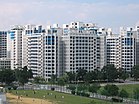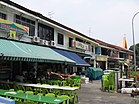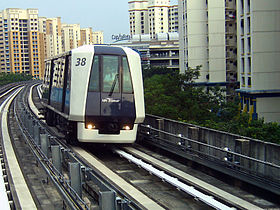Sengkang, Singapura: Perbedaan antara revisi
Hanamanteo (bicara | kontrib) + |
Hanamanteo (bicara | kontrib) + |
||
| Baris 82: | Baris 82: | ||
== Etimologi == |
== Etimologi == |
||
Nama ''Sengkang'' bermakna "pelabuhan yang makmum" dalam bahasa Tionghoa. Nama ini berasal dari jalan yang disebut Lorong Sengkang (dalam [[Bahasa Melayu]], ''lorong'' is street and ''sengkang'' is to chock, block or wedge), off Lorong Buangkok. The area was formerly known as ''Kangkar'' (''Gang Jiao'' 港脚) or "foot of the port" as there was once a fishing port located along [[Sungei Serangoon]].<ref name=":0" /><ref name="Jose Raymond">{{cite news|author=Jose Raymond|title=Sengkang takes shape|work=The Straits Times|date=8 February 2000|page=28}}</ref><ref name="The Straits Times Sep 2000">{{cite news|author= |title=Fancy living in an ocean park?|work=The Straits Times|date=24 September 2000|page= }}</ref> |
Nama ''Sengkang'' bermakna "pelabuhan yang makmum" dalam bahasa Tionghoa. Nama ini berasal dari jalan yang disebut Lorong Sengkang (dalam [[Bahasa Melayu]], ''lorong'' is street and ''sengkang'' is to chock, block or wedge), off Lorong Buangkok. The area was formerly known as ''Kangkar'' (''Gang Jiao'' 港脚) or "foot of the port" as there was once a fishing port located along [[Sungei Serangoon]].<ref name=":0" /><ref name="Jose Raymond">{{cite news|author=Jose Raymond|title=Sengkang takes shape|work=The Straits Times|date=8 February 2000|page=28}}</ref><ref name="The Straits Times Sep 2000">{{cite news|author= |title=Fancy living in an ocean park?|work=The Straits Times|date=24 September 2000|page= }}</ref> |
||
== Sejarah == |
|||
[[Image:Anchorvale Gardens, Nov 05.JPG|thumb|175px|left|A typical apartment block in [[Anchorvale]] Gardens, showing the characteristic [[pilotis]] effect on the column façade.]] |
|||
Sengkang originated from the area once called Kangkar, named after the port and fishing village along Sungei Serangoon. By the mid-20th century, the area was home to several [[Rubber tapping|rubber]], [[Piper (plant)|pepper]], and [[pineapple]] plantations.<ref name=":1"/> At that time, the nearest public housing estate then was the Punggol Rural Centre located along Punggol Road.<ref>{{Cite map|author=Mapping Unit of Singapore|title=Singapore Road Map. Punggol|year=1985|publisher=[[Ministry of Defence (Singapore)|Ministry of Defence]]|location=Singapore|scale=1:10,000|series=SMU 1168|edition=3rd|page=11|url=http://www.nas.gov.sg/archivesonline/maps_building_plans/record-details/fad51436-115c-11e3-83d5-0050568939ad|access-date=23 February 2018}}</ref> Sengkang was largely left alone until 1994, when an [[urban design]] team of ten from HDB began conceptualization for a new town in Sengkang. Sengkang was carved up into seven subzones that would house a total of 95,000 public and private housing units in the long term.<ref name="Tee Hun Ching"/><ref name="The Straits Times Sep 2000"/> |
|||
Conjured by local newspapers, Sengkang's theme became 'Town of the Seafarer', which reflects its history as a fishing village.<ref name="Jose Raymond"/><ref name=":1" /> Two sub-themes were assigned to the four neighbourhood areas (namely [[Rivervale, Singapore|Rivervale]], [[Compassvale]], [[Anchorvale]], and [[Fernvale, Singapore|Fernvale]]) of the new town: one reflected Sengkang's marine history, while the other related to the sprawling plantations that previously covered parts of the area. The neighborhoods were each given a name and a [[colour scheme]] to go with their respective themes. The three-storey [[pilotis]] or [[Stilts (architecture)|stilt]] effect was also utilized in the design of housing blocks, to resemble the stilts of fishing villages and trunks of the various plantations of bygone years.<ref name="The Straits Times Sep 2000"/> |
|||
The town's first apartment blocks (known locally as ''flats'') at Rivervale were completed in 1997.<ref name="Tee Hun Ching"/><ref name="Cindy Lim">{{cite news | author = Cindy Lim| title = Slow start in Sengkang |work=The Straits Times| date = 11 April 2000| page=40}}</ref> By August 2001, about 33,700 dwelling units were completed. As of 31 March 2017, there are 65,981 HDB dwelling units in Sengkang.<ref name=":0"/> |
|||
In October 1999, a steering committee chaired by Dr Michael Lim, then Member of Parliament for [[Cheng San Group Representation Constituency]], was formed to look into providing sufficient [[amenities]] in Sengkang New Town. In view of feedback from residents, it completed its report on the need for facilities and services in the new town in July 2000. They coordinated with various organizations to open more void-deck precinct shops, a new shopping mall and childcare centres.<ref name="Tee Hun Ching"/><ref name="Cindy Lim"/><ref name="Natalie Soh and Kenneth Lim">{{cite news | author = Natalie Soh and Kenneth Lim| title = Few amenities in Sengkang |work=The Straits Times| date = 18 June 1999| page=56}}</ref><ref name="The Straits Times Jun 2000">{{cite news | author = | title = More amenities for Sengkang |work=The Straits Times| date = 12 June 2000| page=34}}</ref><ref name="The Straits Times 19 Mar 2006">{{cite news | title = Task force became model for meeting people's needs | newspaper = [[The Sunday Times (Singapore)|The Sunday Times]] | date = 19 March 2006}}</ref><ref>{{cite web|url=https://www.mci.gov.sg/pressroom/news-and-stories/pressroom/2001/4/speech-by-mr-lee-yock-suan-minister-for-information-and-the-arts-and-mp-for-cheng-san-grc-at-the-grand-opening-ceremony-of-rivervale-mall-on-21-april-2001-at-1100am?page=36_6|title= speech by Mr Lee Yock Suan|author=Ministry of Communications and Information|date=21 April 2001|access-date=6 February 2018}}</ref> |
|||
== Lihat pula == |
== Lihat pula == |
||
Revisi per 26 November 2019 06.21
Halaman ini sedang dipersiapkan dan dikembangkan sehingga mungkin terjadi perubahan besar. Anda dapat membantu dalam penyuntingan halaman ini. Halaman ini terakhir disunting oleh Hanamanteo (Kontrib • Log) 1809 hari 612 menit lalu. Jika Anda melihat halaman ini tidak disunting dalam beberapa hari, mohon hapus templat ini. |
Sengkang | |||||||||
|---|---|---|---|---|---|---|---|---|---|
| Transkripsi Other | |||||||||
| • Chinese | 盛港 | ||||||||
| • Pinyin | Shèng Gǎng | ||||||||
| • Malay | Sengkang | ||||||||
| • Tamil | செங்காங் | ||||||||
From top left to right: Panoramic view of Sungei Serangoon with Rivervale on the west bank, Compassvale, Jalan Kayu, Sengkang LRT Line, Ranggung LRT Station, Sengkang Sculpture Park, Fernvale Primary School | |||||||||
| Koordinat: 1°23′30″N 103°53′40″E / 1.39167°N 103.89444°E | |||||||||
| Country | |||||||||
| Region | North-East Region
| ||||||||
| CDCs | |||||||||
| Pemerintahan | |||||||||
| • Mayors | Central Singapore CDC
North East CDC | ||||||||
| • Members of Parliament | Ang Mo Kio GRC
Pasir Ris-Punggol GRC Punggol East SMC Sengkang West SMC | ||||||||
| Luas | |||||||||
| • Total | 10,59 km2 (409 sq mi) | ||||||||
| • Residential | 3,97 km2 (153 sq mi) | ||||||||
| Populasi | |||||||||
| • Total | 240.640 | ||||||||
| • Kepadatan | 0,23/km2 (0,59/sq mi) | ||||||||
| Postal district | 19, 28 | ||||||||
| Dwelling units | 59,497 | ||||||||
| Projected ultimate | 92,000 | ||||||||
Sengkang adalah kawasan perencanaan dan kota tempat tinggal yang bertempat di Daerah Timur Laut, Singapura. Kota ini memiliki jumlah penduduk terbanyak kedua di daerah ini, dengan 232.100 penduduk tinggal di kota ini pada 2017.[2] Sengkang berbatasan dengan Seletar dan Punggol di utara, Pasir Ris dan Paya Lebar di barat, Hougang dan Serangoon di selatan, serta Yishun dan Ang Mo Kio di barat.
Kota ini awalnya merupakan desa nelayan, yang kemudian berkembang dengan cepat lewat ambisi Lembaga Perumahan dan Pembangunan untuk bertransformasi menjadi kawasan perumahan yang sepenuhnya matang.[4][5]
Etimologi
Nama Sengkang bermakna "pelabuhan yang makmum" dalam bahasa Tionghoa. Nama ini berasal dari jalan yang disebut Lorong Sengkang (dalam Bahasa Melayu, lorong is street and sengkang is to chock, block or wedge), off Lorong Buangkok. The area was formerly known as Kangkar (Gang Jiao 港脚) or "foot of the port" as there was once a fishing port located along Sungei Serangoon.[5][6][7]
Sejarah

Sengkang originated from the area once called Kangkar, named after the port and fishing village along Sungei Serangoon. By the mid-20th century, the area was home to several rubber, pepper, and pineapple plantations.[8] At that time, the nearest public housing estate then was the Punggol Rural Centre located along Punggol Road.[9] Sengkang was largely left alone until 1994, when an urban design team of ten from HDB began conceptualization for a new town in Sengkang. Sengkang was carved up into seven subzones that would house a total of 95,000 public and private housing units in the long term.[4][7]
Conjured by local newspapers, Sengkang's theme became 'Town of the Seafarer', which reflects its history as a fishing village.[6][8] Two sub-themes were assigned to the four neighbourhood areas (namely Rivervale, Compassvale, Anchorvale, and Fernvale) of the new town: one reflected Sengkang's marine history, while the other related to the sprawling plantations that previously covered parts of the area. The neighborhoods were each given a name and a colour scheme to go with their respective themes. The three-storey pilotis or stilt effect was also utilized in the design of housing blocks, to resemble the stilts of fishing villages and trunks of the various plantations of bygone years.[7]
The town's first apartment blocks (known locally as flats) at Rivervale were completed in 1997.[4][10] By August 2001, about 33,700 dwelling units were completed. As of 31 March 2017, there are 65,981 HDB dwelling units in Sengkang.[5]
In October 1999, a steering committee chaired by Dr Michael Lim, then Member of Parliament for Cheng San Group Representation Constituency, was formed to look into providing sufficient amenities in Sengkang New Town. In view of feedback from residents, it completed its report on the need for facilities and services in the new town in July 2000. They coordinated with various organizations to open more void-deck precinct shops, a new shopping mall and childcare centres.[4][10][11][12][13][14]
Lihat pula
Rujukan
- ^ Key Statistics | HDB Annual Report 2014/2015 (Laporan). Housing and Development Board. hlm. 10. Diarsipkan dari versi asli tanggal 4 March 2016. Diakses tanggal 17 February 2018.
- ^ a b "Statistics Singapore - Geographic Distribution - 2018 Latest Data". Diakses tanggal February 11, 2019.
- ^ "Land Area and Dwelling Units by Town". Data Singapore. 2016. Diakses tanggal 26 January 2018.
- ^ a b c d Tee Hun Ching (24 September 2000). "Life behind the vales". The Straits Times.
- ^ a b c Housing and Development Board (4 October 2017). "Sengkang | HDB InfoWEB" (dalam bahasa Inggris). Diakses tanggal 29 December 2017.
- ^ a b Jose Raymond (8 February 2000). "Sengkang takes shape". The Straits Times. hlm. 28.
- ^ a b c "Fancy living in an ocean park?". The Straits Times. 24 September 2000.
- ^ a b Kesalahan pengutipan: Tag
<ref>tidak sah; tidak ditemukan teks untuk ref bernama:1 - ^ Mapping Unit of Singapore (1985). Singapore Road Map. Punggol (Peta) (edisi ke-3rd). 1:10,000. SMU 1168. Singapore: Ministry of Defence. hlm. 11. Diakses tanggal 23 February 2018.
- ^ a b Cindy Lim (11 April 2000). "Slow start in Sengkang". The Straits Times. hlm. 40.
- ^ Natalie Soh and Kenneth Lim (18 June 1999). "Few amenities in Sengkang". The Straits Times. hlm. 56.
- ^ "More amenities for Sengkang". The Straits Times. 12 June 2000. hlm. 34.
- ^ "Task force became model for meeting people's needs". The Sunday Times. 19 March 2006.
- ^ Ministry of Communications and Information (21 April 2001). "speech by Mr Lee Yock Suan". Diakses tanggal 6 February 2018.
Daftar pustaka
- Victor R Savage, Brenda S A Yeoh (2003). Toponymics – A Study of Singapore Street Names. Singapore: Eastern Universities Press. ISBN 981-210-205-1.
- Tommy Koh; Timothy Auger; Jimmy Yap; Ng Wei Chian, ed. (2006). Singapore: The Encyclopedia. Singapore: Editions Didier Millet. ISBN 981-4155-63-2.
- "Transcript of Prime Minister Lee Hsien Loong's National Day Rally English Speech on 19 August 2007 at NUS University Cultural Centre". Ministry of Information, Communications and the Arts. 19 August 2007. Diarsipkan dari versi asli tanggal 27 September 2007. Diakses tanggal 2 September 2007.









